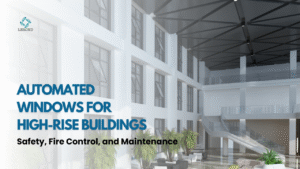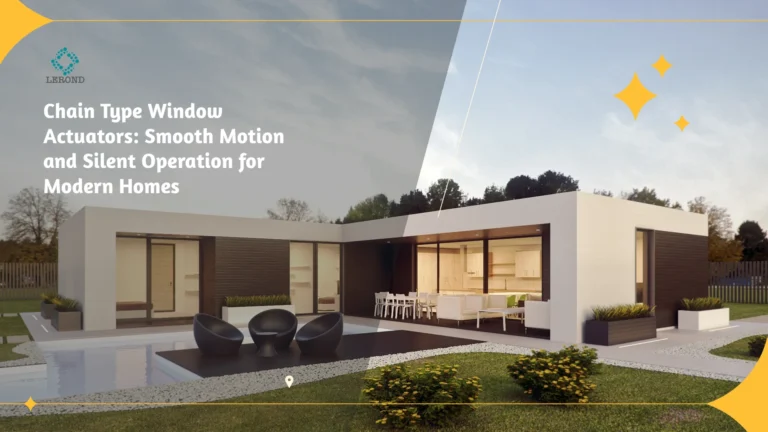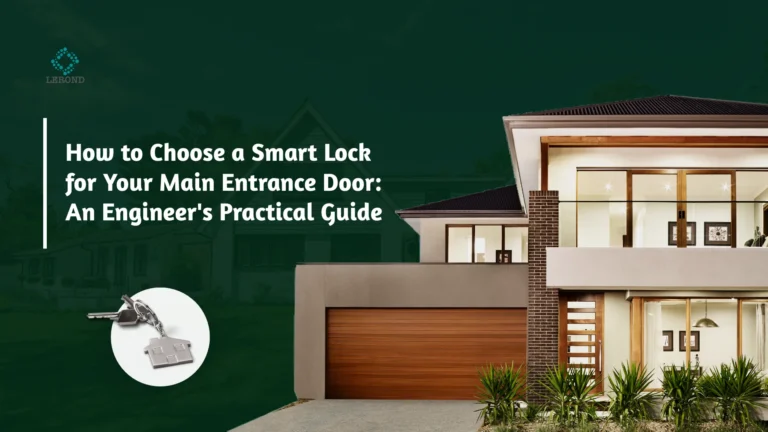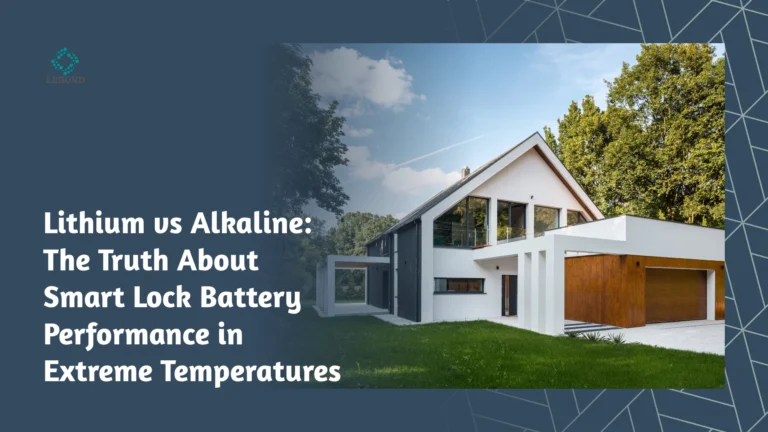🏙️ The Rise of High-Rise Intelligence
In the last decade, the global skyline has grown taller and denser—with cities like Dubai, Shanghai, and London leading the vertical urbanization wave. But building upward comes with complex technical demands: ventilation, fire safety, maintenance, and occupant comfort must now be solved at scale and height.
Enter: automated windows.
These are no longer luxury add-ons. In modern mid- to high-rise construction, automated actuators and control systems are becoming essential components of architectural engineering, demanded by building codes, safety consultants, and forward-thinking developers.
🔥 1. Fire and Smoke Control: Meeting Life-Safety Codes
One of the most critical applications of automated windows is in smoke ventilation systems. In the event of a fire, smart window actuators can open specific windows automatically to:
- 🚪 Allow smoke to escape
- 🚒 Create safe egress routes for occupants
- 🧯 Maintain air pressure balance between escape corridors and fire zones
📜 Code Compliance Examples:
- EN 12101-2 in Europe mandates certified natural smoke and heat exhaust ventilation (NSHEV) systems.
- High-rise buildings in China and the EU require actuator-based openable window zones as part of emergency planning.
LEROND’s actuator systems, including chain, push-rod, and linear track types, can be integrated into fire alarm or BMS systems for automatic smoke release with precise timing and redundancy.
🧰 2. Maintenance and Cleaning: Safe Access, Smart Control
At 20+ stories, manual window operation and cleaning is both unsafe and impractical. Automated window systems solve this in two key ways:
- ⚙️ Centralized or remote operation allows facility managers to open/close window groups for cleaning, ventilation, or maintenance.
- 🛑 Safety interlocks prevent opening under dangerous wind or pressure conditions.
In many cases, LEROND’s programmable actuators can be synced with weather sensors (wind, rain) to prevent accidental opening in storms—a must-have for glass facades in windy coastal cities.
Some systems also include:
- Auto-lock features for child safety in residential towers
- Manual override for cleaning crews
- Tamper-proof settings for commercial tenants
🌬️ 3. Intelligent Natural Ventilation: Toward Green Compliance
Natural ventilation isn’t just about air—it’s about energy efficiency and thermal control. Increasingly, green building certifications (LEED, BREEAM, WELL) incentivize natural airflow strategies to reduce HVAC dependency.
Automated window actuators make this possible through:
- 🌡️ Temperature-triggered open/close cycles
- 📊 CO₂ or humidity sensor integration
- 🔁 BMS-linked sequences for cross ventilation
🌿 Example:
In a passive-cooled school building in Germany, automated top-hung windows opened at night to purge hot air, reducing next-day cooling load by 35%.
For LEROND clients in Europe and the Middle East, we offer custom actuator solutions for ventilation façades, skylights, and atriums—built for integration with Tuya or BACnet protocols.
🏗️ 4. Façade Integration and Structural Considerations
Designing for automation doesn’t stop at the actuator. For high-rises, actuator-based windows must be:
- 💪 Structurally reinforced to resist external pressures
- 🔩 Integrated during façade system engineering (unitized curtain walls, ventilated façades)
- 📐 Compatible with customized opening angles and sash weight
LEROND collaborates with façade consultants and aluminium window manufacturers to ensure:
- Correct force and stroke selection
- Integration of position feedback sensors
- Customized brackets for concealed installation
Our range of chain actuators, rack-and-pinion push actuators, and bottom-hung linkages are tailored for these unique envelope challenges.
🧠 5. Centralized Control Systems: From BMS to Smart Living
Large-scale buildings require centralized control, not just switches. LEROND’s actuators support:
- 🖥️ Integration with Building Management Systems (BMS) like KNX, BACnet, Modbus
- 📱 Mobile app control for facility teams
- 🧲 Open APIs for customized scenarios (e.g., energy-saving algorithms)
For smart homes, this extends to voice control, preset ventilation modes, and real-time fault alerts—thanks to our Tuya ecosystem compatibility.
📈 Future Outlook: Regulation, Safety, and Automation Converging
By 2030, the global market for window actuators is projected to reach USD 6.5 billion, with the high-rise segment growing at over 7% CAGR (MarketsandMarkets, 2024). Factors driving this include:
- Tightened fire ventilation laws
- Increased green building certification requirements
- Demand for automated maintenance and energy optimization
For architects, engineers, and developers, the question is no longer if you need automated windows—but how soon you can standardize them across your portfolio.
🧩 LEROND’s Approach: Modular. Scalable. Compliant.
t LEROND, we design and supply:
- ✅ Chain, push-rod, and slide-arm actuators for all window types
- ✅ BMS-ready and wireless-enabled models
- ✅ European-standard smoke control compliance
- ✅ High-load, weatherproof designs for extreme conditions
Whether you’re developing a commercial tower in Dubai or a residential high-rise in Paris, we help you deliver safe, smart, and scalable window automation—backed by professional after-sales and integration support.
🔚 Final Thought:
In high-rise buildings, windows are no longer passive design elements. They are safety tools. Ventilation engines. Energy controllers.
And when automated, they help cities breathe smarter, safer, and more sustainably.




